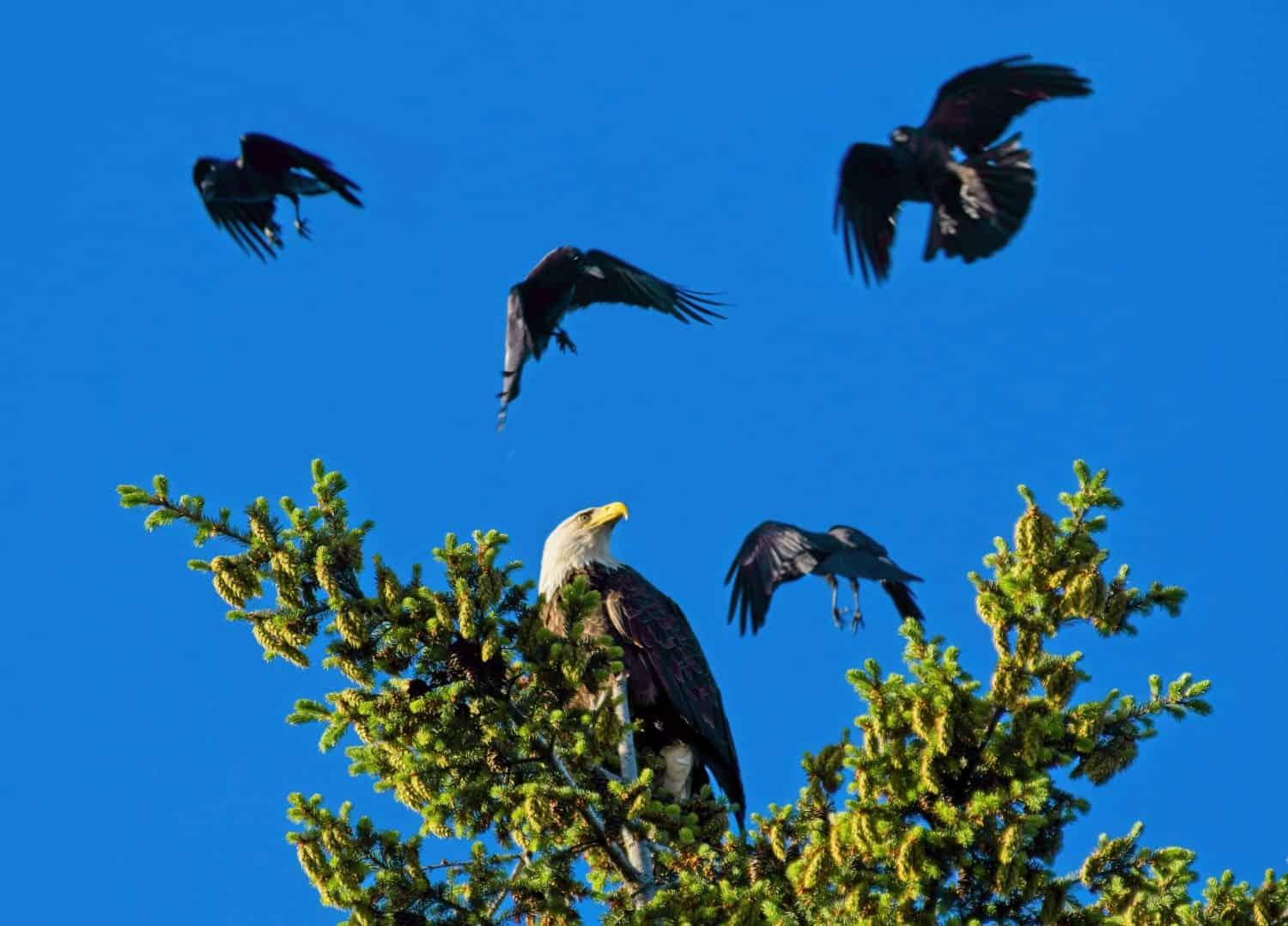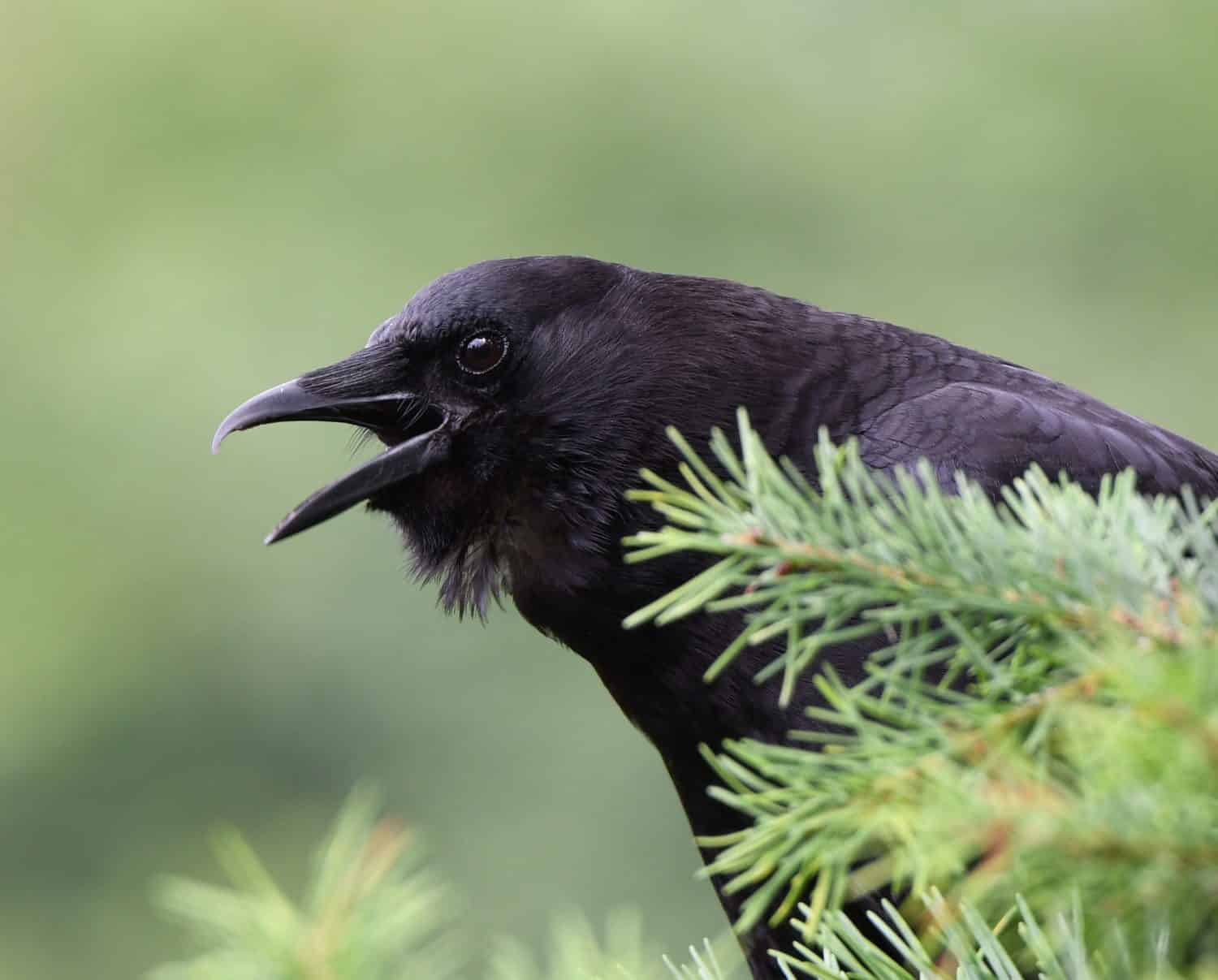Highly intelligent and social birds, crows integrate various communication methods within their social groups to relay important messages, socially bond, and express emotions.
This guide will delve into how crows communicate via vocalizations and body language.
Read on to learn more!
How Crows Communicate: Vocalizations
Crows, members of the Corvus genus and Corvidae family, are known for their “caw” vocalizations. Rather than being a single-dimensional sound, however, this vocalization can convey various meanings depending on the pitch, loudness, harmonics, length of call, repetition, individual accent, etc. The caw vocalization of crows carries unique signatures that allow individuals to recognize each other in their group, spookily called a murder. One study found that the calls of crows are so specific that an individual’s call can relay their identity, sex, and age. In addition to caws, crows also produce coos, rattles, and clicks.
Collective Defense
Crows tend to make loud, distinctly harsh-sounding caws when mobbing a predator, such as a large owl. These vocalizations are known as scolding calls. The mobbing crows produce these anti-predator caws in overlapping vocalizations, which some researchers believe may give the effect of a larger and more formidable group. Crows will also produce specific caws to recruit others nearby in the murder to defend against a predator near nests or feeding areas,
In one study, researchers found that American crows (Corvus brachyrhynchos) displayed anti-predator mobbing and scolding caws when presented with the sight of a human next to a deceased crow and a red-tailed hawk (Buteo jamaicensis) paired with a deceased crow. Additionally, crows can recognize and remember human faces. After just one session of seeing a specific person associated with the sight of a dead crow, the crows remembered the human’s face and produced scolding caws around that person for the next six weeks.

Crows will collectively defend against predators through mobbing and scolding calls.
©pr2is/Shutterstock.com
Collective Defense and Generational Learning
In another study, researchers demonstrated that crows shared knowledge of dangerous human individuals with their peers and offspring, which resulted in increasing scolding of that person within the population over the next five years. In the study, two researchers wore distinctive masks and trapped, marked, and released 7-15 crows at five sites near Seattle. The study aimed to observe the event’s effect on the crows’ behavior towards the researchers wearing the distinctive masks.
The researchers then wore distinctive or neutral masks around the trapping sites. Within the first two weeks after the trapping, about 26% of crows encountered near the sites scolded the individuals with distinctive masks. After 1.25 years, that number rose to 30.4%. And after three years, that number climbed to 66% of the population. Over time, there was no increase in the rate of scolding towards researchers wearing the neutral mask, demonstrating intergenerational and collective knowledge sharing about individuals perceived as dangerous by the crows.
Initiating Group Movement
When an individual or small group of crows fly away, they often produce distinct caw patterns that likely recruit other crows within the murder to join them. As highly social animals, it benefits crows to have distinctive calls for recruiting others when traveling away or toward the site of food, shelter, or nests.
Territorial Calls
When producing territorial calls, crows often make a distinctive rattling vocalization along with the cawing. They produce this rattling sound by rapidly vibrating their vocal organ, a syrinx. These harsh, rattly calls can function to both ward off conspecifics (of the same species) from other murders and to deter other species.

Crows use a harsh rattle in addition to their caws when producing territorial calls.
©Smileynulk/Shutterstock.com
How Crows Communicate: Body Language
Crows employ a variety of postural cues to express mood, intent, reproductive status, territorial claims, and more.
When mobbing predators or engaging in agonistic displays with conspecifics, crows often display a fanned and rapid flicking tail, ruffled and puffed out feathers, outheld wings, and upheld or stretched forward head.
Crows may accentuate their calls when recruiting others to a food source by lowering their heads and bowing their bodies while bobbing. This bobbing motion is synchronized with the duration of each call.
A crow that intends to appear acquiescing toward an imposing conspecific may hold their body lower to the ground, angle their bill downward, pull the feather around their body inward, and fluff out their feathers on the top of their head. In contrast, an imposing crow will hold themselves upright, walk exaggeratedly, point their bill upward with their beak open, and fluff out the feathers around their throat and legs.

An imposing crow may appear as large as possible during an agonistic interaction with a conspecific.
©Digital Wildlife Scotland/Shutterstock.com
The photo featured at the top of this post is © Elliotte Rusty Harold/Shutterstock.com
Thank you for reading! Have some feedback for us? Contact the AZ Animals editorial team.







